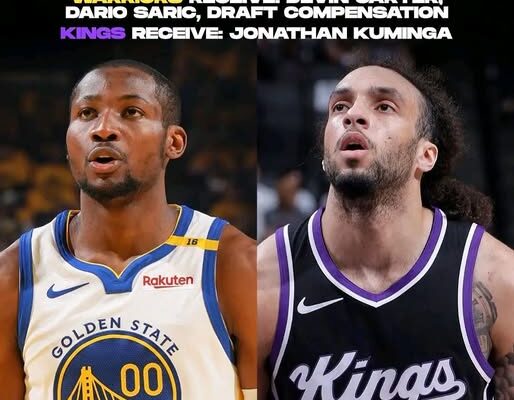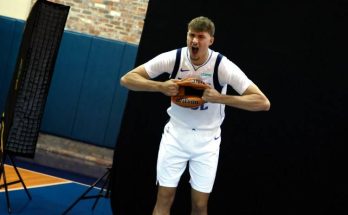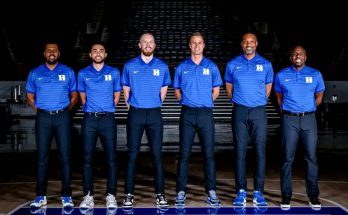SAN FRANCISCO, CA – The Golden State Warriors have once again sent shockwaves through the NBA landscape, though this time, the reaction from a vocal segment of their fanbase and a considerable portion of the basketball punditry is less about jubilation and more about bewilderment. Just days after the onset of free agency, the Warriors officially inked 39-year-old veteran center Al Horford to a two-year contract. While Horford brings undeniable championship pedigree, defensive versatility, and valuable floor spacing, the decision has left many scratching their heads, particularly in light of the perceived “snub” of a familiar, and significantly younger, frontcourt option: Dario Šarić.
The sentiment reverberating across social media, encapsulating the general confusion, is perhaps best captured by the succinct, exasperated question: “What y’all doing… He just took a nap instead of Dario Šarić, what’s that?” This pithy observation, accompanied by the rallying cry of #stephencurry, #nbabasketball, and #NBA, speaks volumes about the perceived misstep in the Warriors’ offseason strategy. It suggests that while the franchise is clearly in “win-now” mode, their method of achieving this goal, particularly regarding their frontcourt depth, is generating more head-shaking than celebratory fist-pumps.
Al Horford is undeniably a celebrated figure. His recent NBA championship with the Boston Celtics (in 2024, as per prior context) solidifies his status as a winner. His ability to hit the three-pointer (36.3% last season), guard multiple positions, and operate as a high-IQ passer from the high post are all highly desirable traits in Steve Kerr’s system. He’s a professional’s professional, a respected leader, and brings invaluable experience to an aging core of Stephen Curry (37), Jimmy Butler (36, reportedly acquired by the Warriors), and Draymond Green (35).
However, the “nap” comment highlights the glaring concern: his age. At 39, Horford is entering uncharted territory for a key contributor on a championship contender. While his durability has been impressive, Father Time remains undefeated. The two-year commitment, likely utilizing the taxpayer midlevel exception, means the Warriors are hard-capped and have limited flexibility. This isn’t a long-term solution; it’s a short-term patch on a team that needs to squeeze every ounce of championship potential out of its rapidly diminishing window. The question isn’t whether Horford can contribute, but whether he can maintain a high enough level of contribution over a full season, and especially in the physically demanding playoffs, against younger, more athletic bigs. The concern is that the “nap” refers to a perceived slowing down, a lack of the vibrant energy that more youthful options could provide.
The immediate comparison to Dario Šarić is telling because Šarić was literally just with the Warriors during the 2023-24 season. Fans are intimately familiar with his strengths and weaknesses. Šarić, at 31 years old (he was 29 during his Warriors stint, and is 31 now as of July 2025), represents a significantly younger option than Horford, with a playing style that also involves floor spacing and passing.
Šarić’s 2023-24 season with the Warriors saw him average 8.0 points, 4.4 rebounds, and 2.3 assists while shooting 37.9% from three-point range. He fit well into the Warriors’ offensive flow, demonstrating a keen understanding of their movement and cutting principles. While he struggled defensively at times and was prone to some inconsistency, he showed flashes of being a viable stretch-big option off the bench. He ultimately signed a two-year, $10.6 million contract with the Denver Nuggets last summer, exercising his player option for the 2025-26 season at $5.4 million.
The “What’s that?” sentiment regarding Šarić stems from several points:
- Familiarity and Chemistry: Šarić already has experience in the Warriors’ system, with built-in chemistry with Stephen Curry, Draymond Green, and the coaching staff. He wouldn’t need a lengthy adjustment period, unlike a new veteran.
- Youth vs. Longevity: At 31, Šarić has several more prime years than Horford. While Horford’s championship experience is coveted, the concern is that he might simply be too old for a physically taxing NBA season. Šarić offers more long-term durability, even if his ceiling isn’t as high as Horford’s was in his prime.
- Similar Skillset, Different Age Curve: Both players are known for their ability to stretch the floor and pass. While Horford is likely a better defender, Šarić offers a valuable offensive punch that the Warriors still need. The question becomes whether the marginal defensive upgrade from a 39-year-old Horford outweighs the age gap and potential for more consistent production from a 31-year-old Šarić.
- Cost-Effectiveness: Šarić’s player option for $5.4 million for 2025-26 is remarkably similar to the projected $5.7 million taxpayer midlevel exception the Warriors likely used on Horford. Given the comparable cost, the age difference becomes even more puzzling to some.
The Warriors’ decision to sign Horford, following the reported acquisition of Jimmy Butler and the departure of Kevon Looney, unequivocally signals an “all-in” approach for the next two seasons. This is the last dance for a significant portion of their dynasty-era core. Stephen Curry, still an elite offensive talent, is under contract until the 2026-27 season. The management’s goal is clear: provide Curry with the best possible chance to win another championship before his incredible run ends.
However, this aggressive “win-now” strategy carries substantial risks, and the Horford signing is a prime example:
- Over-Reliance on Aging Stars: The core is now notably older. While experience is vital, reliance on players in their mid-to-late 30s for heavy minutes in a grueling 82-game season and playoff run is a gamble. Injuries become more frequent, and recovery times lengthen.
- Hard Cap and Limited Flexibility: Using the taxpayer midlevel exception means the Warriors are hard-capped. This severely limits their ability to make additional moves or adjustments if injuries or underperformance occur throughout the season. They have essentially bet big on this roster.
- Sacrificing Future for Present: While drafting Kai Sotto is a future-oriented move, the more immediate signings reflect a complete prioritization of the present. This means potentially less playing time for promising young players like Moses Moody, Brandin Podziemski, and Trayce Jackson-Davis, whose development might be stifled by a crowded veteran lineup.
- “One Last Hurrah” Mentality: While admirable, this mentality can sometimes lead to decisions that look good on paper (e.g., signing a champion like Horford) but don’t fully account for the practicalities of a long season or the inevitable decline of age.
The #stephencurry hashtag accompanying the criticism is crucial. Fans are acutely aware that every move the Warriors make now is about maximizing Curry’s remaining years. The hope is that Horford’s spacing will further unlock Curry’s off-ball brilliance, and his defensive presence will alleviate some of the burden on the smaller Curry. However, the underlying question for fans is whether these moves truly position Curry for another title, or if they are simply desperate attempts to prolong a window that might be closing regardless.
The signing of Al Horford is a testament to the Golden State Warriors’ relentless pursuit of another NBA championship. It demonstrates their willingness to invest heavily, both financially and in terms of roster construction, in a veteran presence. Yet, the accompanying sentiment of “What y’all doing?” and the wistful mention of Dario Šarić highlight the real anxieties within the fanbase. The Warriors are placing a significant bet on wisdom and experience over youth and perhaps more consistent durability. Whether this bold strategy leads to another parade down Market Street or a premature “nap” in the playoffs remains to be seen.



